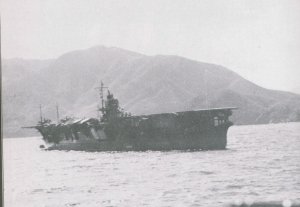![]() The Pacific War Online Encyclopedia
The Pacific War Online Encyclopedia
|
| Previous: Sorong | Table of Contents | Next: South China Sea |

| Tonnage | 15,900 tons standard displacement 18,800 tons fully loaded |
| Dimensions | 746'4" by 69'11" by 25' 227.48m by 21.31m by 7.62m |
| Maximum speed |
34.5 knots |
| Complement | 1100 |
| Aircraft | 711' by 85'4" (216.7m by 26m) flight deck 3 elevators 57 aicraft operational 68 aircraft total |
| Armament | 6x2 5"/40
dual-purpose guns 14x2 25mm AA guns |
| Protection | 1.6" (41mm) Ducol belt with splinter bulkhead 1" (25mm) hangar deck over machinery 2.2" (56mm) hangar deck over magazines and aviation fuel bunkers |
| Machinery |
4-shaft geared Kampon
turbines with HP, IP, and LP turbines plus cruising turbine
(152,000 shp) 8 Kampon Ro boilers |
| Bunkerage | 3670 tons fuel oil 150,000 gallons (570,000 liters) aviation gasoline |
| Range | 7750 nautical miles (14,350 km) at 18 knots |
The Soryu was completed in 1937. She was originally envisioned as a hybrid cruiser-carrier to evade the restrictions of the naval disarmament treaties, but with Japan preparing to withdraw from the treaty system, she was redesigned as a high-speed carrier with a large air group. She retained the cruiser hull and machinery, which gave her nearly 35 knots of speed. Drawing on the lessons of earlier Japanese carrier design, she was built with a small island well forward, a single long flight deck, two hangar decks to accommodate a large air group, and exhaust funnels trunked over the side. However, her speed and aircraft capacity came at the cost of being poorly protected. particularly underwater. She was originally to have been protected against 8" shellfire, but the final protection scheme was barely adequate against destroyer gunfire. The designers seem to have oriented the protection scheme against bombs and torpedoes rather than gunfire. In many respects she reflected the Japanese military ideal of emphasizing speed and offensive power over defensive capability.
The hangar decks were divided into three bays by fire
doors located just forward of the bow and amidships elevators. The
large aft bays served torpedo
bombers, the middle bays served dive bombers, and the
smaller forward bays served fighters.
This arrangement also allowed fighters to be more easily brought
to the forward flight deck and torpedo bombers to the aft flight
deck, accommodating their relative takeoff run requirements. Soryu
was also the first Japanese carrier to be equipped with a
crash barrier, and its aviation stores were blanketed with carbon
dioxide as a fire prevention measure.
The ship was formally authorized in 1934, but by then
the Navy had already prepared plating at the yard (Kure Naval Arsenal). In spite of
this eagerness to put her in service, Soryu did not
commission until 29 December 1937, a year later than the Navy had
hoped. This was largely due to redesign in the wake of the Tomozuru
and 4 Fleet incidents, which revealed stability problems in
Japanese warship designs. Welding was used extensively as a
weight-saving measure.
Soryu was part of the Pearl Harbor Attack Force when war broke out in the Pacific. She was sunk by dive bombers during the Battle of Midway. Three bombs penetrated her hangar deck and set off uncontrollable fires among aircraft being readied for launch.

|
 |
 |
 |
References
Parshall and
Tully (2006)
Peattie (2001)
The Pacific War Online Encyclopedia © 2007, 2009, 2016 by Kent G. Budge. Index